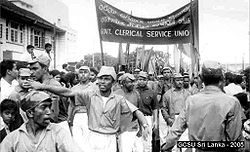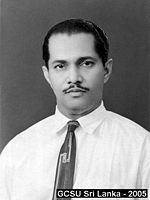
GCSU Sri Lanka
Encyclopedia
The Government Clerical Service Union (GCSU) is a trade union
of clerical workers who work in the public sector in Sri Lanka
. This was formed in the 1920s when Sri Lanka (Ceylon) was under British colonial rule. It is a politically independent trade union but the majority of the activists were Communists early in its history.
The schools formed by Christian missionaries taught the English language to the students and they were employed in the public sector because of their knowledge of the English language. After 1815 the British colonial rulers started educating Sri Lanka's public workers about the administration rules and regulations. They also held examinations for the clerical workers to upgrade their working level. The famous manual among the public sector workers named Administration Rules and Regulations (ARR) is still used in Sri Lanka. An examination was held for the administration officers called the Ceylon Administrative Service (CAS) exam. After passing it they were graded as CAS officers.
From beginning of the GCSU in February 1920 to the political independence of Sri Lanka in 1948 it has to struggle with British rulers in order to secure workers' rights and national independence.
 After the political independence from British colonial rulers in February 1948 the GCSU became a more powerful force in Sri Lanka. Most of the GCSU members were members of Lanka Sama Samaja Party
After the political independence from British colonial rulers in February 1948 the GCSU became a more powerful force in Sri Lanka. Most of the GCSU members were members of Lanka Sama Samaja Party
(LSSP) and Communist Party of Sri Lanka
(CP-Moscow wing). Dr. N.M. Perera the leader of LSSP was openly supporting the activities of the GCSU by protecting workers' rights.
(J.R. Jayawardena) right-wing policies. But the GCSU still remained as a force among public-sector workers.
 I. J. Wickrema was a promising leader of the GCSU in the 1960s. He led the GCSU during the "Golden era" in its history. The total number of members was around 30,000 out of 50,000 clerical workers in Sri Lanka in the 1960s. He organised branch committees of the union throughout the country, giving more strength to it. He was elected as secretary of the union and later became its President. During his period in office (1965–70), many incidents happened in Sri Lanka's politics and they reacted to the changes by taking the side of the worker. Anyone can refer to their official news paper "Red Tape" and get an idea of how they reacted to the changing political situation of the country.
I. J. Wickrema was a promising leader of the GCSU in the 1960s. He led the GCSU during the "Golden era" in its history. The total number of members was around 30,000 out of 50,000 clerical workers in Sri Lanka in the 1960s. He organised branch committees of the union throughout the country, giving more strength to it. He was elected as secretary of the union and later became its President. During his period in office (1965–70), many incidents happened in Sri Lanka's politics and they reacted to the changes by taking the side of the worker. Anyone can refer to their official news paper "Red Tape" and get an idea of how they reacted to the changing political situation of the country.
He introduced the Death donation scheme and the Retirement donation scheme from which its members benefited at a time of grief and in the later years of their lives.
laid the foundation stone for the building. Any one who visits the city of Colombo can see the GCSU headquarters building near the Beira lake.
government came into power under the leadership of Junius Richard Jayawardena. He was subjected to political revenge and his close relatives worked in the public sector were transferred to difficult areas. Finally he was sent to the CAS officers pool giving him mental agony and a year later he was retired. He died in late 1979 and his funeral march was organised under the banner of the GCSU.
In May 1989 M.K. Meththananda was shot by insurgents
when he was at home in Tangalle, a village of deep south. He supported Provincial Councils, which were formed after the Indo-Lanka Peace Accord signed in July 1987.
Trade union
A trade union, trades union or labor union is an organization of workers that have banded together to achieve common goals such as better working conditions. The trade union, through its leadership, bargains with the employer on behalf of union members and negotiates labour contracts with...
of clerical workers who work in the public sector in Sri Lanka
Sri Lanka
Sri Lanka, officially the Democratic Socialist Republic of Sri Lanka is a country off the southern coast of the Indian subcontinent. Known until 1972 as Ceylon , Sri Lanka is an island surrounded by the Indian Ocean, the Gulf of Mannar and the Palk Strait, and lies in the vicinity of India and the...
. This was formed in the 1920s when Sri Lanka (Ceylon) was under British colonial rule. It is a politically independent trade union but the majority of the activists were Communists early in its history.
British colonial era
British colonialists who ruled Sri Lanka (Ceylon) from March 1815 educated the Sri Lankan people to work in the public sector because it was very difficult to bring sufficient administrative staff from the UK to administer the colony.The schools formed by Christian missionaries taught the English language to the students and they were employed in the public sector because of their knowledge of the English language. After 1815 the British colonial rulers started educating Sri Lanka's public workers about the administration rules and regulations. They also held examinations for the clerical workers to upgrade their working level. The famous manual among the public sector workers named Administration Rules and Regulations (ARR) is still used in Sri Lanka. An examination was held for the administration officers called the Ceylon Administrative Service (CAS) exam. After passing it they were graded as CAS officers.
Before 1948
In the 1920s the clerical workers of Sri Lanka formed a union to protect their workers rights.From beginning of the GCSU in February 1920 to the political independence of Sri Lanka in 1948 it has to struggle with British rulers in order to secure workers' rights and national independence.
From 1948 to 1977

Lanka Sama Samaja Party
The Lanka Sama Samaja Party is a Trotskyist political party in Sri Lanka....
(LSSP) and Communist Party of Sri Lanka
Communist Party of Sri Lanka
The Communist Party of Sri Lanka is a communist political party in Sri Lanka. At the last legislative elections, on 2 April 2004, the party was part of the United People's Freedom Alliance that won 45.6% of the popular vote and 105 out of 225 seats....
(CP-Moscow wing). Dr. N.M. Perera the leader of LSSP was openly supporting the activities of the GCSU by protecting workers' rights.
After 1977
After the year 1977, the situation for Sri Lanka's left-wing political movements was getting worse due to the former President of Sri Lanka Junius Richard Jayawardena'sJunius Richard Jayewardene
Junius Richard Jayewardene , famously abbreviated in Sri Lanka as JR, was the first executive President of Sri Lanka, serving from 1978 till 1989. He was a leader of the nationalist movement in Ceylon who served in a variety of cabinet positions in the decades following independence...
(J.R. Jayawardena) right-wing policies. But the GCSU still remained as a force among public-sector workers.
Most powerful union

He introduced the Death donation scheme and the Retirement donation scheme from which its members benefited at a time of grief and in the later years of their lives.
Building the headquarters
Under I.J. Wickrema's leadership the GCSU started work to build their own headquarters in front of the "Lake House" (the office of the government news papers). Famous Sri Lanka's drama player Henry Jayasena staged dramas to raise funds for the new building. Former Sri Lanka's Prime Minister Mrs.Sirimavo R.D. BandaranaikeSirimavo Bandaranaike
Sirimavo Ratwatte Dias Bandaranaike was a Sri Lankan politician and the world's first female head of government...
laid the foundation stone for the building. Any one who visits the city of Colombo can see the GCSU headquarters building near the Beira lake.
Leaving the GCSU
I.J. Wickrema left the union at the end of 1970 as he was appointed as a CAS officer. The 1977 government of Mrs.Sirimavo was over and the new United National PartyUnited National Party
The United National Party, often referred to as the UNP ), , is a political party in Sri Lanka. It currently is the main opposition party in Sri Lanka and is headed by Ranil Wickremesinghe...
government came into power under the leadership of Junius Richard Jayawardena. He was subjected to political revenge and his close relatives worked in the public sector were transferred to difficult areas. Finally he was sent to the CAS officers pool giving him mental agony and a year later he was retired. He died in late 1979 and his funeral march was organised under the banner of the GCSU.
GCSU martyrs
In June 1947 V. Kandasamy a Tamil national, became victim to the atrocities of the British colonial rulers and sacrificed his young life to the bullet, on their way to Kolonnawa after a general strike meeting at Hyde Park Colombo.In May 1989 M.K. Meththananda was shot by insurgents
Insurrection 1987-89
The 1987-89 insurrection in Sri Lanka, in which around 50,000 lives were lost, was carried out by the Janatha Vimukthi Peramuna, a Marxist Sinhalese political party in Sri Lanka.-Leadup to conflict in the 1980s:...
when he was at home in Tangalle, a village of deep south. He supported Provincial Councils, which were formed after the Indo-Lanka Peace Accord signed in July 1987.

